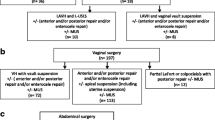Abstract
The aim of this study was to examine the association between surgeon and hospital characteristics on in-hospital outcome after ureteral reimplantation in children. Patients < 18 years undergoing vesicoureteral reimplantation (n = 3,109) were identified in Kids’ Inpatient Database, an administrative database containing discharge records from 27 states during 2000 in the US. Based on patient volume in 2000, surgeons were designated as low volume (< 11 procedures), medium volume (11–20 procedures) and high volume (> 20 procedures) surgeons. Length of stay and hospital charges were analyzed using multivariate linear regression analysis. A significant association between shorter length of stay and higher surgeon volume (p = 0.02) was observed that was independent of children’s hospital status, hospital volume and other hospital characteristics. Length of stay was 20% shorter when the procedure was performed by the highest volume surgeons compared to when performed by the lowest. No significant effect of surgeon volume on hospital charges, however, was observed. Higher surgeon volume was associated with shorter length of stay but no difference in hospital charges among children undergoing vesicoureteral reimplantation.

Similar content being viewed by others
References
Arant BS Jr (1991) Vesicoureteric reflux and renal injury. Am J Kidney Dis 17:491–511
Bieri M, Smith CK, Smith AY, et al (1998) Ipsilateral ureteroureterostomy for single ureteral reflux or obstruction in a duplicate system. J Urol 159:1016–1018
Duong DT, Parekh DJ, Pope JC IV, et al (2003) Ureteral reimplantation without urethral catheterization shortens hospital stay without compromising postoperative success. J Urol 170:570–1573
Marotte JB, Smith DP (2001) Extravesical ureteral reimplantations for the correction of primary reflux can be done as outpatient procedures. J Urol 165:2228–2231
McCool AC, Joseph DB (1995) Postoperative hospitalization of children undergoing cross-trigonal ureteral reimplantation. J Urol 154:794–796
Miller OF, Bloom TL, Smith LJ, et al (2002) Early hospital discharge for intravesical ureteral reimplantation. J Urol 167:2556–2559
Cain MP, Husmann DA, McLaren RH, et al (1995) Continuous epidural anesthesia after ureteroneocystostomy in children. J Urol 154:791–793
Gonzalez A, Smith DP (1998) Minimizing hospital length of stay in children undergoing ureteral reimplantation. Urology 52:501–504
Snow BW, Cartwright PC, Young MD (1996) Does surgical subspecialization in pediatrics provide high-quality, cost-effective patient care? Pediatrics 97:14–17
Kogan BA, Baskin LS, Allison MJ (1998) Length of stay for specialized pediatric urologic care. Arch Pediatr Adolesc Med 152:1126–1131
Silber JH, Gleeson SP, Zhao H (1999) The influence of chronic disease on resource utilization in common acute pediatric conditions. Financial concerns for children’s hospitals. Arch Pediatr Adolesc Med 53:169–179
Merenstein D, Egleston B, Diener-West M (2005) Lengths of stay and costs associated with children’s hospitals. Pediatrics 115(4):839–844
Iezzoni LI (2003) Coded data from administrative sources. In: Iezzoni LI (eds) Risk adjustment for measuring health care outcomes. Health Administration Press, Chicago, pp 83–138
Burbige KA (1991) Ureteral reimplantation: a comparison of results with the cross-trigonal and Politano-Leadbetter techniques in 120 patients. J Urol 146:1352
Kennelly MJ, Bloom DA, Ritchey ML, et al (1995) Outcome analysis of bilateral Cohen cross-trigonal ureteral reimplantation. Urology 46:393–395
Lapointe SP, Barrieras D, Leblanc B, et al (1998) Modified Lich-Gregoir ureteral reimplantation: experience of a Canadian center. J Urol 159:1662–1664
Steinbrecher HA, Rangecroft L (1997) The use of the detrusorrhaphy for vesico-ureteric reflux: the way forward? BJU 79:971–974
Shahian DM, Normand SLT (2003) The volume-outcome relationship: From Luft to Leapfrog. Ann Thorac Surg 75:1048–1058
Author information
Authors and Affiliations
Corresponding author
Rights and permissions
About this article
Cite this article
Dickstein, R.J., Barone, J.G., Liao, J.G. et al. The effect of surgeon volume and hospital characteristics on in-hospital outcome after ureteral reimplantation in children. Ped Surgery Int 22, 417–421 (2006). https://doi.org/10.1007/s00383-006-1679-7
Accepted:
Published:
Issue Date:
DOI: https://doi.org/10.1007/s00383-006-1679-7




